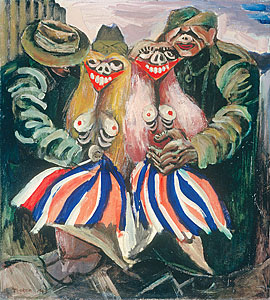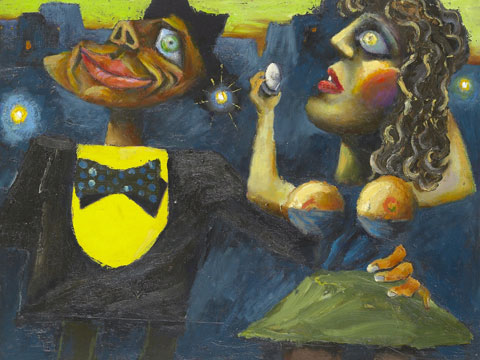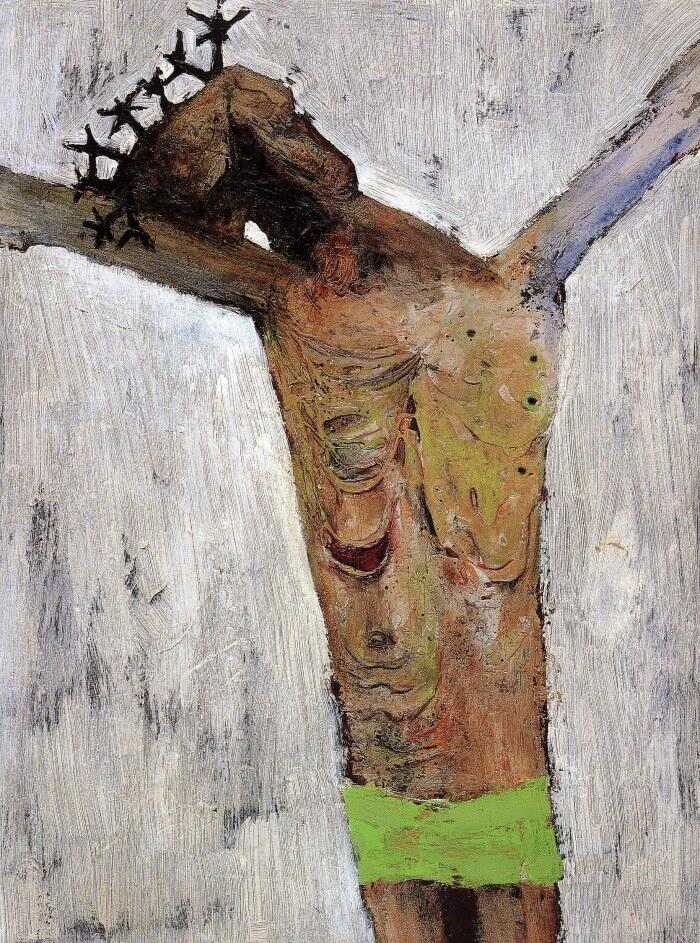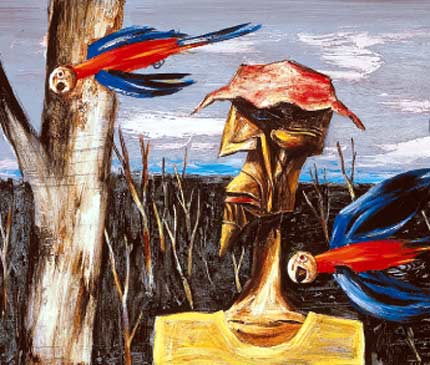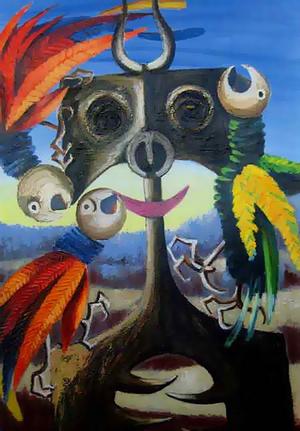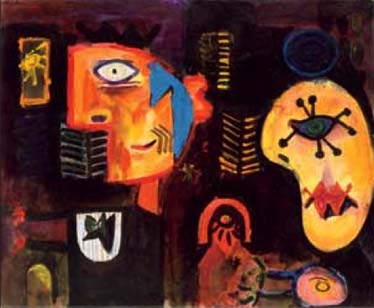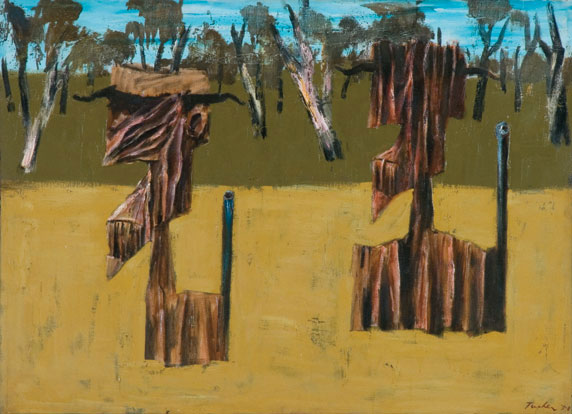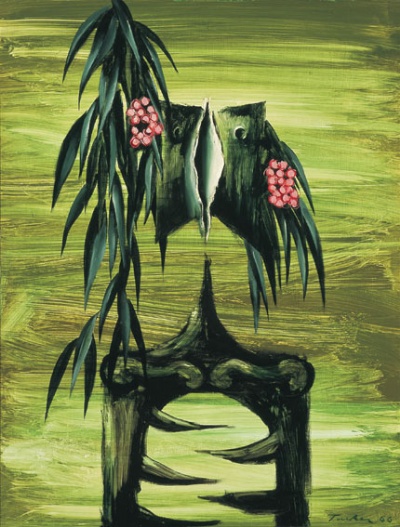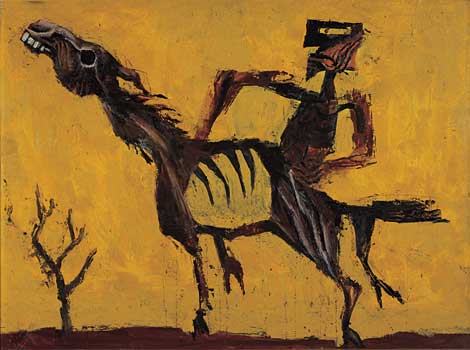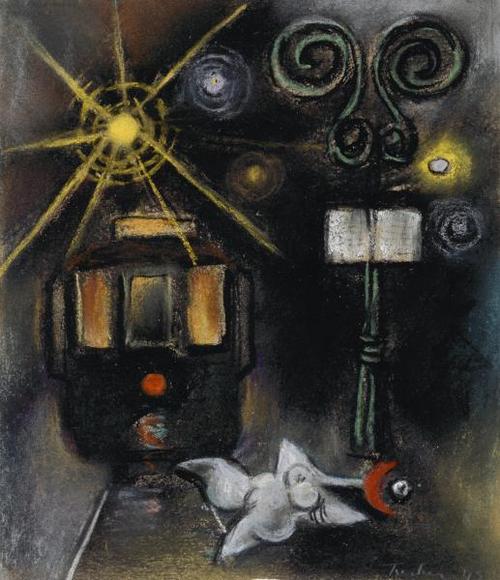<Back to Index>
- Physicist Johann Christian Poggendorff, 1796
- Painter Albert Lee Tucker, 1914
- Empress and Autocrat of All the Russias Elizaveta Petrovna, 1709
PAGE SPONSOR
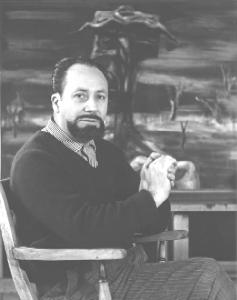
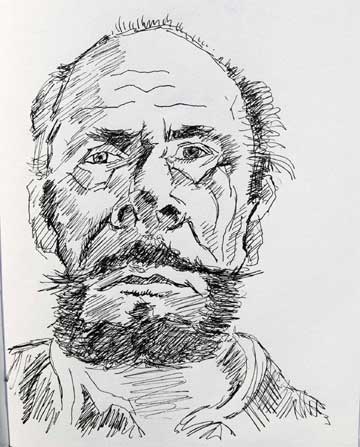
Albert Lee Tucker (29 December 1914 – 23 October 1999), a pivotal Australian artist, was a member of the Heide Circle, a group of leading modernist artists and writers that centred on the art patrons John and Sunday Reed, whose home, "Heide", located in Bulleen, near Heidelberg (outside Melbourne), was a haven for the group. Tucker's major series Images of modern evil (1943 – 47) depicted prostitutes and soldiers in Melbourne.
Tucker loathed school and willingly left at 14 and became a commercial artist. He attended life drawing classes at the Victorian Artists Society where he honed his brilliant draughtsmanship.
Throughout
the 1930s, Tucker continued to refine his skills, while experimenting
with his homemade paints. In the late 1930s, two important émigré artists arrived in Melbourne –
Josl Bergner and Danila Vassilieff. Their realistic representations had
a great effect on Tucker’s work, as he too, began to explore
confronting truths of the depression. However, Tucker’s work began to
take more shape in the next decade, the “Angry Decade” of the 1940s, as
the artists responded to the horror of war, incensed by the abolition
of hope just after the depression appeared to be clearing up. Tucker's perceptive response to the world around him was recognised by two people - Sunday and John Reed. These two saw connections between Tucker's work and other artists, angry too at the social situation. Sunday
and John Reed were members of the Contemporary Arts Society, set up to
promote these emerging artists, known as the modernists. The Society
was set up in 1938 by George Bell,
in opposition to the government Australian Academy of Art, which was
believed to promote conservative art and not the modernists. The modernists included Albert Tucker, Joy Hester, Sidney Nolan, John Perceval, Arthur Boyd and Noel Counihan.
These artists met to discuss material on a regular basis. Tucker
enjoyed being part of what he saw as a like minded group of artists,
all focused on producing works along similar themes, in response to
war, depression and moral degradation. The artists also brought
influences from European movements such as Surrealism, Cubism, Expressionism, Dadaism and Constructivism. From this "Angry" group of modernists, formed a group known as the Angry Penguins, which also included many social realists. The modernists and social realists shared
the same concerns, and their work became focused on war and its
horrors, along with moral decay and the emergence of Americanism. The Angry Penguins was also a publication that these artists wrote for, published by Max Harris. Tucker’s original influences, Bergner and Vassilieff, were part of this group. The Angry Penguins was the major outlet for the expression of avant - garde ideas. In
1941, Tucker married fellow artist Joy Hester, and they had a son,
Sweeney. It emerged many years later that Tucker was not the boy's
biological father — it was probably Australian jazz drummer Billy Hyde, with whom Hester had had a brief affair. When Hester was later diagnosed with Hodgkin's lymphoma,
she gave Sweeney into the care of the Reeds, who adopted him. Joy
Hester died in 1960, and in 1964 Tucker married Barbara Bilcock.
Sweeney committed suicide in 1979. Tucker's main inspirations can be divided into periods, although he was originally influenced by the depression, post - impressionists, expressionists and social realists, also keeping in mind his involvement with the Angry Penguins, and his responses to war. Tucker's
first significant works were produced during his involvement in the
army. In 1940, Tucker was called up for army service and spent most of
his time working in Heidelberg Military Hospital drawing patients
suffering from horrific wounds and mental illnesses as a result of war.
He produced three important works at this stage, Man at Table, a pen
and ink illustration of a man whose nose had been sliced off by a shell
fragment, The Waste Land, an image of death sitting on a stool watching
and waiting, and Floating Figures, of two figures floating down a hall,
a third with a demented smile. All of these images illustrated the
horror and madness of war. At this time, Tucker was influenced by raw
images of death and horror, wishing to present a blunt, direct,
succinct image of war’s consequences. This is similar to the way social
realists wish to present their messages, although Tucker’s actual
delivery was surrealistic and expressionistic in appearance. In
1942, Tucker was discharged from the war and returned to a Melbourne he
did not like. He was particularly disgusted, but inspired by scenes of
Melbourne’s nightlife, of a city he felt demonstrated a collapse of
simple morality. He was shocked and outraged by images of schoolgirls
trotting home to reappear wearing skimpy miniskirts made from Union
Jacks and American flags, ready for a wild night in St. Kilda with the drunken American and Australian soldiers. In response he painted Victory Girls,
an impression of American soldiers, pig - like, grinning and clutching
the meager frames of young women in bawdy red lipstick, as if
possessions or prizes of war, representing a clear confusion as to what
war actually reaps. This painting was the catalyst for his series of
works known as the Images of Modern Evil, all depicting similar
nightlife and exploitation of women figures, or comodification of sex,
symbolized in recurring motifs; sticks or skin - toned blobs with red
smiles and single, elaborately styled eyes with curly lashes. As Tucker
continues creating these images, the subjects become less and less
human and occupy space in more and more disconnected ways; floating or
melting, being abducted from above, slumped on the side of the road,
lying in the shadows of movie theaters. His source is clear, after
seeing immoral scenes of sex, abduction, confusion and clear gender
stereotyping, and maintains the same surreal, expressionistic delivery
with socially realistic content. The
post - war period did not bring peace to visions at first he had hoped
for, explaining humanity's status after war as “irreparably damaged”,
viewing the world with great anxiety and a loss of hope. In early 1947,
Tucker traveled to Japan with the Australian army as an art
correspondent, required to interpret the devastation he saw there. He
produced a monochrome pen drawing called Hiroshima; it contains no
figures, just the aftermath of complete devastation, with somber tents
and shelters littering the landscape. During this time, Tucker was
influenced by his sense of hopelessness after seeing the war,
depression, and the fact that society had never improved. Upon
returning, he broke up with Joy Hester in 1945. Out of bitterness,
Tucker left for Europe later in 1947 for the next 13 years. In England
and Europe until 1958, Tucker painted many prostitutes, highly
influenced by the fact that no city seemed to be free of this “disease”
of prostitution, and so painted them in abundance. He then moved to New York in 1958 and his subjects switched from the city to outback Australia, feeling rather homesick. Where some works of Sidney Nolan and Russell Drysdale had
reached international level, Tucker rejected them as being
nationalistic. He depicted the landscape as being a harsh, barren and
sterile wasteland. He distorted stereotypes and icons of the Australian
bush, including convicts, Burke and Wills and the Kelly Gang.
He was influenced by the sheer barrenness and hopelessness that the
outback conveyed, and added these icons as pawns to the outback’s
deadly game. Throughout
the 1960s, Tucker began to face many personal traumas. He had begun to
form a good relationship with his son, Sweeny, who had been adopted by
Sunday and John Reed, but unfortunately he committed suicide in 1979. A
few years later, the Reeds both died within a week of each other. He
began to feel that many of the people he had influenced in his life
were quickly slipping away from him, looking back at Joy Hester, who
had also died in 1960. As a tribute, and to immortalise his
contemporaries, he produced the "Series of Faces I have met". The
series saw Tucker move away from his most celebrated themes, and to
variations of the Antipodean Head, a representation of an explorer’s
conflict with the environment that eventually fuses the two together to
become of the same element, as both the landscape and the heads were
created using the same medium, texture and colour. His other major
subjects were the “intruders” or “fauns” that became mindless metallic
beings that patrolled dead environments with guns and weaponry. This
added to his recurring themes of hopelessness and loss. Tucker's
style, subjects and attitude stay the same throughout his life as an
artist. His attitude always comes across as perceptive, pessimistic,
disgusted and generally critical of the environment around him.
Whenever he portrays males or females together, they seem to be
sexually confused – the females maintain an extreme prostitute image
and the males appear lustful and greedy. He often depicts scenes of
madness, destruction and horror especially in response to the war. He
portrays many scenes of hopelessness in his post - war stage, of the
desert, Hiroshima and of his personal losses. His
style retains a surreal, expressionistic quality. He often places
subjects on barren, dream like and hostile plains, with confused or
distorted bodies, appearing surrealistic. He enjoys disfiguring his
subjects’ forms to emphasise an issue or point, whilst being very
expressive in his appliance of mediums, linking to expressionism. His
messages however are ultimately of social realist quality, apart from
his surreal explorations into his losses in his final artistic stage.
He always wants to bluntly and confrontingly display social issues that
are harsh, but real and very much a part of society. Tucker's
subjects often recur. He starts with many psychologically disturbed
subjects in his war period, and also wounded subjects. He then moves to
a subject of modern evil, with the recurring motif of the fake smile,
single eye and pole and/or blob - like masses for bodies, with pig - like
males. His subjects then move to hopelessness and loss in the post - war
period, including the desert, Australian icons, Antipodean Heads,
“Fauns” and Hiroshima. The theme linking all of these is often moral
confusion.''
